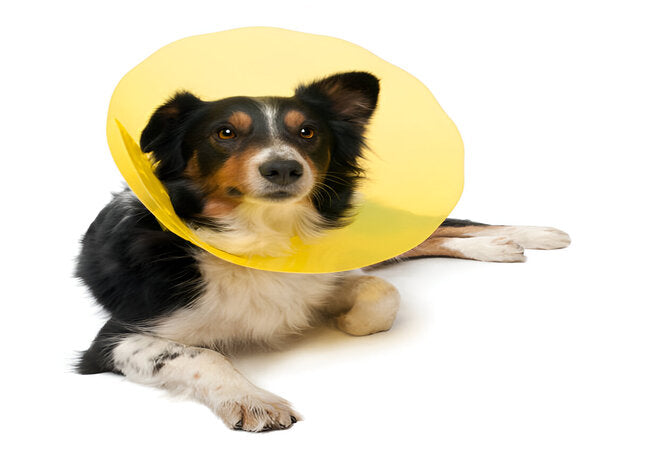Vet‑Approved 2025 Guide: Cone of Shame & Easier Alternatives for Dogs 🐶✨💉

In this article
Vet‑Approved 2025 Guide: Cone of Shame & Easier Alternatives for Dogs 🐶✨💉
By Dr. Duncan Houston BVSc
Dubbed the “Cone of Shame,”the Elizabethan recovery cone is a time-tested tool preventing dogs from licking or biting healing wounds 🎯. First introduced in 1962 by Dr. Frank Johnson, these cones—plastic or fabric—are designed to give incisions the best chance to heal.
🔍 Why a Cone Is Needed & How It Fits
Used after surgeries or to protect irritated skin, the cone’s rigid design keeps dogs from self-trauma that could worsen wounds or spread infections. Proper fit is key: it should extend past the nose and allow two fingers under the smooth neck edge.
❗ Downsides of Traditional Plastic Cones
- Uncomfortable, noisy, and can block vision or hearing.
- May bump into furniture or hinder eating/drinking.
- Stressful—leading to anxiety or the dog attempting to remove it.
🧷 Top Cone Alternatives for 2025
When a traditional cone isn’t ideal, consider these vet-approved options:
1. Soft Cone Collars
Made from foam, fabric, or soft mesh—more comfortable yet preserving the cone shape. Pets often can sleep better, and it's machine washable.
2. Inflatable (Donut) Collars
Resembling a neck pillow, this inflatable option maintains peripheral vision and comfort while limiting neck turn. However, flexible dogs might still reach wounds.
3. Padded Rings & Neck Braces
Soft “doughnut” or neck-control collars restrict head movement similarly to cervical braces. Great visibility, but size must prevent body rotation or reach.
4. Recovery (Surgical) Suits
Bodysuits covering the trunk or limbs are ideal for chest/abdomen wounds. Machine-washable and comfortable—but not suitable for face, leg, or tail wounds.
5. Recovery Sleeves / Leg Covers
Sewn leg garment that protects bandaged limbs—easy to clean and less bothersome, pending correct sizing.
6. T-Shirts or Doggy Tees
Cover small wounds on the torso. Simple, soft, and easy—but loose clothing may not stay in place and could cause moisture buildup.
⚖️ Pros & Cons
| Option | Pros | Cons |
|---|---|---|
| Soft cones | Comfortable, protective | Less durable, vision still limited |
| Inflatable collars | Easy eating/drinking, better vision | May not prevent all wounds access |
| Recovery suits | Cozy, washable, full-body coverage | Not ideal for face/limb wounds |
| Sleeves/T-shirts | Lightweight, easy to wear | Can shrink or shift, not for all wounds |
⚠️ Tips for Choosing & Using Alternatives
- Select based on wound location, pet size, and behavior.
- Always supervise during wear—higher risk of collapse or removal.
- Size must effectively prevent reaching the wound.
- Check with your vet before switching—some wounds need full isolation.
🐾 Improving Comfort & Compliance
- Gradually introduce your dog to the device with treats and praise.
- Provide raised feeders for easier eating/drinking.
- Discourage them from removing the device—gentle but firm encouragement can help.
🛠️ Enrichment Tools During Recovery
- Ask A Vet: Use the app for follow-up advice on fit, wound checks, and anxiety management without clinic visits.
📞 When to Consult Your Vet
- If your dog can reach the wound despite the barrier.
- If the device causes choking, breathlessness, or neck irritation.
- If your pet becomes very anxious or refuses food and water.
- If the healing isn’t progressing or wounds show signs of infection.
🏁 Final Thoughts
The "cone of shame" may protect wounds, but it doesn’t have to distress your dog 🐕. Vet-approved alternatives like soft cones, inflatable collars, and surgical suits can offer effective protection with less stress. Work with your vet to pick the right option, supervise wear, and use supportive enrichment, like those from Ask A Vet, for a smooth, comfortable recovery.
Want guidance on selecting or fitting a recovery collar? Visit Ask A Vet for expert advice tailored to your dog’s needs 🐾✨.






